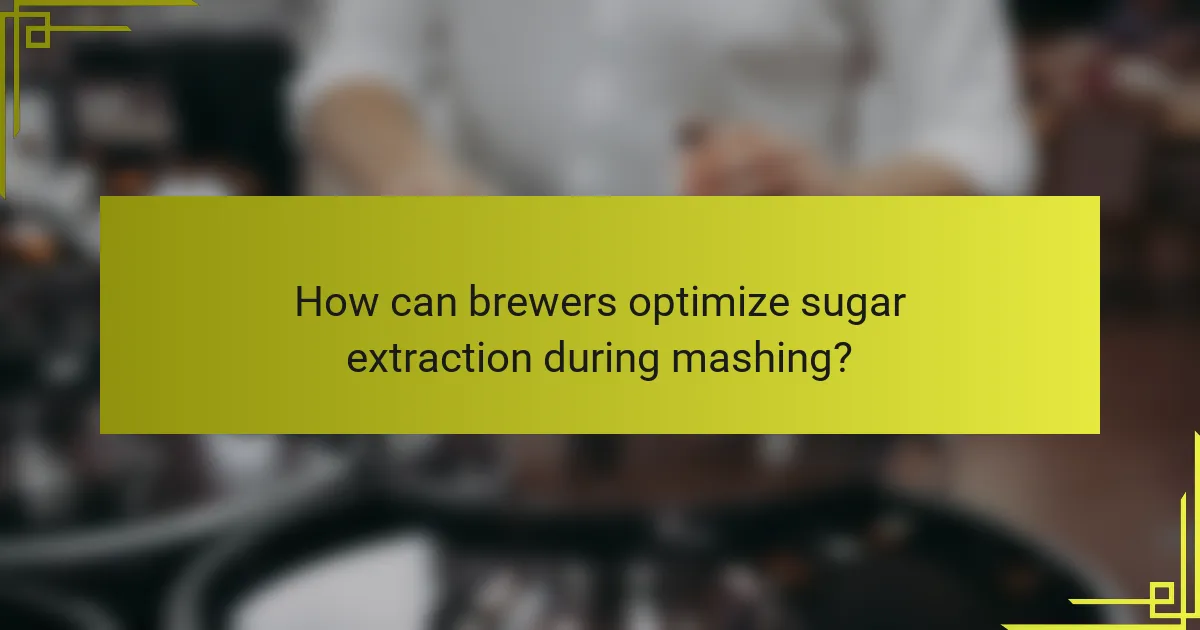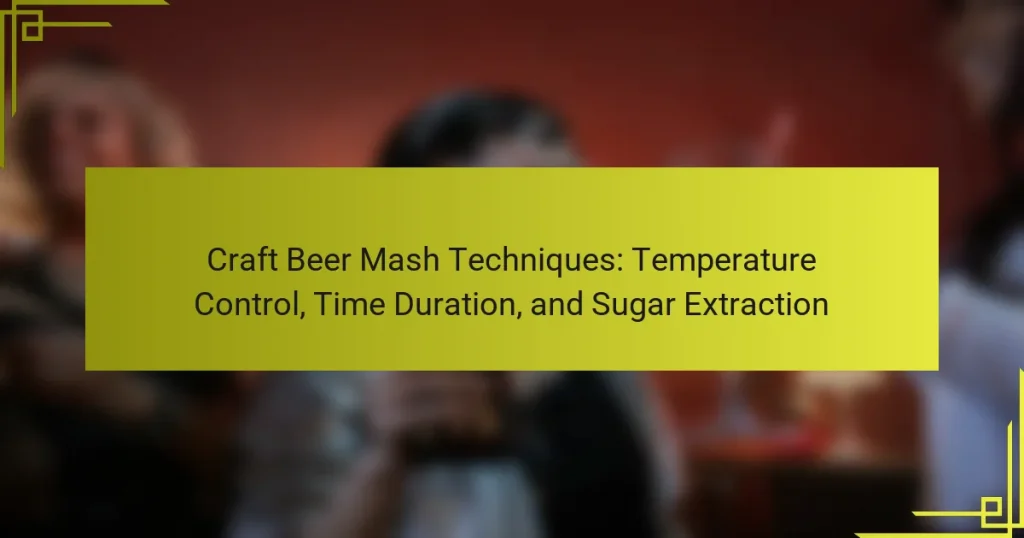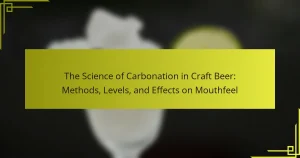Craft beer mash techniques are essential methods in the brewing process that convert starches in grains into fermentable sugars. Key elements of these techniques include temperature control, time duration, and specific mash processes such as infusion, decoction, and step mashing. Temperature regulation typically occurs within the range of 150°F to 160°F (65°C to 71°C) to optimize enzyme activity, while the mashing duration generally spans 60 to 90 minutes to enhance sugar extraction. By understanding and applying these techniques, brewers can achieve desired beer profiles and specific gravity levels, ultimately influencing the flavor and quality of the final product.

What are Craft Beer Mash Techniques?
Craft beer mash techniques are methods used to convert starches in grains into fermentable sugars during brewing. These techniques include temperature control, time duration, and specific mash processes. Temperature control involves adjusting the heat during mashing to optimize enzyme activity. For example, mashing at 150-155°F (65-68°C) promotes the conversion of starches into sugars. Time duration typically ranges from 60 to 90 minutes, allowing sufficient time for enzymatic reactions. The mash process may involve single infusion, step mashing, or decoction mashing, each affecting flavor and sugar extraction. These techniques are essential for producing a desired beer profile and achieving specific gravity levels.
How do temperature control, time duration, and sugar extraction relate to mashing?
Temperature control, time duration, and sugar extraction are critical components of the mashing process in brewing. Temperature control affects enzyme activity during mashing. Different temperatures activate different enzymes, which convert starches into sugars. For example, a temperature of around 150°F (65°C) optimizes alpha-amylase, which produces fermentable sugars.
Time duration influences the extent of sugar extraction. Longer mashing times allow for more complete conversion of starches to sugars. Typically, a mash duration of 60 to 90 minutes is recommended for optimal extraction.
Sugar extraction is the primary goal of mashing. The process aims to maximize the yield of fermentable sugars for fermentation. Higher sugar levels lead to increased alcohol content in the final beer. Thus, effective management of temperature control and time duration directly impacts sugar extraction efficiency.
What is the significance of temperature in the mashing process?
Temperature in the mashing process is crucial for enzymatic activity. It determines the effectiveness of starch conversion into fermentable sugars. Generally, lower temperatures (around 140°F or 60°C) favor beta-amylase activity, producing more fermentable sugars. Higher temperatures (around 158°F or 70°C) enhance alpha-amylase activity, resulting in a fuller-bodied beer. The optimal temperature range for mashing is typically between 148°F and 158°F. This range balances sugar extraction and flavor development. Studies show that precise temperature control can significantly influence the final beer profile. Therefore, mastering temperature in mashing is essential for achieving desired beer characteristics.
How does time duration impact the efficiency of sugar extraction?
Time duration significantly impacts the efficiency of sugar extraction during the mashing process. Longer mashing times generally enhance the enzymatic activity, leading to greater sugar conversion from starches. For instance, a mash duration of 60 to 90 minutes typically allows sufficient time for enzymes like alpha-amylase and beta-amylase to break down starches effectively. Research indicates that extending the mash time beyond 90 minutes can yield diminishing returns, as enzymes may become less effective due to temperature changes or substrate depletion. In practical terms, optimal sugar extraction is often achieved within a 60 to 90-minute timeframe, balancing efficiency and enzyme activity.
What role does sugar extraction play in the overall brewing process?
Sugar extraction is crucial in the brewing process as it converts starches from grains into fermentable sugars. This process occurs during the mashing stage, where heat activates enzymes that break down starches. The resulting sugars are essential for yeast fermentation, which produces alcohol and carbonation.
Effective sugar extraction depends on temperature control and time duration during mashing. Higher temperatures can favor the extraction of specific sugars, while longer mash times can enhance overall yield. Studies show that optimal temperature ranges, typically between 150°F and 160°F, maximize sugar conversion efficiency.
The quality and quantity of sugars extracted directly influence the beer’s flavor, body, and alcohol content. Therefore, proper management of sugar extraction is fundamental to crafting high-quality beer.
Why is temperature control crucial in craft beer mashing?
Temperature control is crucial in craft beer mashing because it directly affects enzyme activity and sugar extraction. Different temperatures activate specific enzymes that convert starches into fermentable sugars. For example, temperatures around 150°F (65°C) favor the enzyme alpha-amylase, which produces a higher level of fermentable sugars. Conversely, temperatures around 140°F (60°C) activate beta-amylase, leading to a higher proportion of unfermentable sugars. This variation influences the beer’s body, mouthfeel, and overall flavor profile. Accurate temperature control ensures optimal enzyme performance, resulting in the desired sugar profile for fermentation. Studies show that maintaining precise temperatures can lead to a more consistent and high-quality final product.
What are the optimal temperature ranges for different mash techniques?
The optimal temperature ranges for different mash techniques vary based on the desired outcome. For protein rest, the ideal range is 122°F to 130°F. This temperature helps in breaking down proteins and improving beer clarity. For saccharification, the range is typically 148°F to 158°F. This range promotes the conversion of starches into fermentable sugars. For mash-out, the temperature should reach 170°F. This halts enzymatic activity and prepares the wort for lautering. These temperature ranges are supported by brewing science. They ensure effective sugar extraction and desired beer characteristics.
How do temperature fluctuations affect enzyme activity during mashing?
Temperature fluctuations negatively impact enzyme activity during mashing. Enzymes, like amylase, function optimally within specific temperature ranges. For instance, alpha-amylase works best between 70°C and 80°C. If the temperature deviates significantly, enzyme activity can decrease. Lower temperatures can slow down the reaction rates, while higher temperatures may denature the enzymes. Denaturation leads to a loss of enzyme functionality. Consistent temperature control ensures efficient sugar extraction. Studies indicate that maintaining stable temperatures enhances fermentation efficiency and beer quality.

What are the different types of mash techniques?
The different types of mash techniques include infusion, decoction, and step mashing. Infusion mashing involves adding hot water to crushed grains, allowing enzymes to convert starches to sugars. This technique is common due to its simplicity and effectiveness. Decoction mashing requires boiling a portion of the mash and then returning it to the main mash. This method enhances flavor and can produce more complex profiles. Step mashing involves raising the temperature of the mash in stages. Each stage activates different enzymes, optimizing sugar extraction. These techniques are essential for producing various beer styles with distinct flavor profiles.
What is infusion mashing and how does it work?
Infusion mashing is a brewing technique where crushed grains are mixed with hot water. This process activates enzymes in the malt. These enzymes convert starches into fermentable sugars. The mixture is held at specific temperatures to optimize this conversion. Typically, infusion mashing involves a single temperature rest, usually between 150°F and 160°F (65°C to 71°C). At this temperature, enzymes like alpha-amylase and beta-amylase work effectively. The duration of the mash usually ranges from 60 to 90 minutes. This method is popular for its simplicity and efficiency in sugar extraction.
What are the benefits of using infusion mashing in craft beer production?
Infusion mashing enhances sugar extraction in craft beer production. This technique allows for precise temperature control, optimizing enzyme activity. It promotes the conversion of starches into fermentable sugars. Infusion mashing can result in a more consistent and predictable wort profile. It typically requires less equipment and is easier for homebrewers to implement. Studies show that infusion mashing can lead to higher efficiency in sugar extraction, improving overall yield. This method is particularly effective for lighter beer styles that benefit from a clean, crisp finish.
How does infusion mashing differ from other techniques?
Infusion mashing involves maintaining a single temperature for the entire mash process, typically around 150-158°F. This contrasts with other techniques like decoction mashing, which involves multiple temperature steps and boiling portions of the mash. Infusion mashing allows for a more straightforward process and is often easier for homebrewers. It primarily focuses on converting starches to sugars efficiently at a consistent temperature. In comparison, techniques such as step mashing involve raising the temperature in stages to target different enzymes. Each method affects the final beer’s flavor and body. Infusion mashing is widely used due to its simplicity and effectiveness in sugar extraction.
What is decoction mashing and what are its advantages?
Decoction mashing is a brewing technique where a portion of the mash is boiled and then returned to the main mash. This method allows for enhanced extraction of sugars and flavors from the grains. Decoction mashing can improve the body and mouthfeel of the beer. It also contributes to a more complex flavor profile. The process typically involves multiple temperature steps. These steps help in achieving optimal enzyme activity. Historical brewing practices often utilized decoction mashing for traditional beer styles. Its advantages include increased efficiency in sugar extraction and improved flavor complexity.
How does the decoction process enhance flavor in craft beer?
The decoction process enhances flavor in craft beer by extracting more complex sugars and flavors from the malt. This method involves boiling a portion of the mash, which caramelizes the sugars. The boiling process also leads to the Maillard reaction, producing rich, toasty flavors. Additionally, it allows for better enzyme activation, improving sugar conversion. Studies show that decoction mashing can result in a fuller-bodied beer. The technique is particularly effective for certain styles, like Märzen and Bock, which benefit from enhanced malt character. Overall, decoction contributes to a more robust flavor profile in craft beer.
What are the challenges associated with decoction mashing?
Decoction mashing presents several challenges. It requires precise temperature control throughout the process. Maintaining the correct temperatures is crucial for optimal enzyme activity. The process is time-consuming, often taking several hours to complete. This extended duration can lead to increased labor costs. Additionally, the complexity of the method can result in inconsistent results. Achieving uniformity in the mash can be difficult due to the multiple steps involved. Lastly, decoction mashing may require specialized equipment, increasing initial investment costs.

How can brewers optimize sugar extraction during mashing?
Brewers can optimize sugar extraction during mashing by carefully controlling temperature and time. The mashing process involves converting starches into fermentable sugars. Ideal temperature ranges for mashing typically fall between 150°F and 160°F (65°C to 71°C). At these temperatures, enzymes like alpha-amylase and beta-amylase effectively break down starches.
Maintaining the mash for 60 to 90 minutes allows sufficient time for enzyme activity. A longer mash duration can enhance sugar extraction but may also lead to unwanted flavors. Additionally, using a well-milled grain ensures better access for enzymes.
Brewing studies indicate that a mash pH of around 5.2 to 5.6 optimizes enzyme performance. Therefore, adjusting water chemistry can further improve extraction efficiency. These methods collectively contribute to higher sugar yields in the final wort.
What techniques can be employed to maximize sugar yield?
To maximize sugar yield, several techniques can be employed during the mashing process. Temperature control is crucial; maintaining specific temperatures activates enzymes that convert starches to sugars. For instance, mashing at around 150°F (65°C) optimizes the activity of alpha-amylase, which breaks down starches effectively.
Time duration also plays a significant role; longer mash times can increase sugar extraction. A typical mash duration ranges from 60 to 90 minutes, allowing ample time for enzymatic activity.
Additionally, the choice of grain can impact yield. Using malted grains with higher diastatic power enhances sugar conversion.
Finally, proper pH levels, ideally between 5.2 and 5.6, facilitate enzyme activity, further maximizing sugar yield. These combined techniques ensure an efficient mashing process and higher sugar extraction for brewing.
How does grain crush size affect sugar extraction efficiency?
Grain crush size significantly affects sugar extraction efficiency. Finer crush sizes increase the surface area of the grain. This allows enzymes better access to starches during the mashing process. Enhanced enzyme activity leads to higher sugar yields. Conversely, a coarser crush may limit sugar extraction. Studies show that optimal crush size ranges from 0.8 to 1.2 mm for maximum efficiency. A study by Bamforth and Ward (2003) in the “Journal of the American Society of Brewing Chemists” supports this finding. The research indicates that finer grinds yield more fermentable sugars. Therefore, adjusting grain crush size is critical for effective sugar extraction in brewing.
What impact does water-to-grain ratio have on sugar extraction?
The water-to-grain ratio significantly impacts sugar extraction during the mashing process. A higher water-to-grain ratio generally leads to better sugar extraction. This is because more water allows for better enzymatic activity and diffusion of sugars. Conversely, a lower ratio can result in insufficient hydration of the grains. Insufficient hydration limits enzyme function, reducing sugar yield. Research indicates that optimal ratios typically range from 1.5 to 2.5 quarts of water per pound of grain. Studies show that maintaining an appropriate ratio maximizes sugar extraction efficiency, leading to higher alcohol content in the final product.
What common mistakes should brewers avoid in the mashing process?
Brewers should avoid several common mistakes in the mashing process. One mistake is not maintaining the correct temperature. Mashing at too low a temperature can result in insufficient sugar extraction. Conversely, mashing at too high a temperature can lead to overly sweet beer. Another error is inadequate mash time. A short mash duration may not fully convert starches into fermentable sugars. Additionally, inconsistent stirring can lead to uneven temperature distribution. Failing to properly measure the grain-to-water ratio can also affect efficiency. Lastly, neglecting to monitor pH levels can hinder enzyme activity during mashing. These mistakes can significantly impact the quality and flavor of the final product.
How can improper temperature control lead to undesirable flavors?
Improper temperature control can lead to undesirable flavors in craft beer. Temperature affects the enzymatic activity during the mash process. If the temperature is too low, enzymes may not fully convert starches to sugars. This can result in a thin, watery beer with inadequate sweetness. Conversely, if the temperature is too high, it can create unwanted flavors. High temperatures can lead to the extraction of tannins from grains. Tannins can impart astringency and bitterness to the beer. Additionally, improper temperatures can promote off-flavors from yeast. Yeast may produce esters or phenols when stressed by high temperatures. These flavors can clash with the intended profile of the beer. Thus, maintaining proper temperature control is crucial for desirable flavor development.
What are the signs of inadequate sugar extraction during mashing?
Signs of inadequate sugar extraction during mashing include low specific gravity readings. This indicates insufficient fermentable sugars in the wort. A lack of sweetness in the wort is another sign. The wort may taste thin or watery. Additionally, an overly cloudy appearance can suggest incomplete starch conversion. Low efficiency percentages in the mash can also indicate problems. A prolonged mash time without improvement in gravity can confirm inadequate extraction. Monitoring these factors is essential for successful brewing.
What best practices can enhance craft beer mash techniques?
Maintaining precise temperature control is crucial for enhancing craft beer mash techniques. Optimal temperatures for mashing typically range from 150°F to 156°F. This range promotes effective enzyme activity for starch conversion. Consistent temperature helps achieve desired sugar extraction rates.
Monitoring mash duration is also essential. A mash time of 60 to 90 minutes allows thorough enzyme activity. Longer mashing can lead to over-extraction of undesirable flavors.
Using a well-insulated mash tun improves temperature stability. This reduces heat loss during the mashing process.
Regularly stirring the mash promotes even temperature distribution. Stirring also helps prevent dough balls, which can hinder sugar extraction.
Lastly, adjusting the grain bill can influence sugar profiles. Incorporating specialty grains can enhance flavor complexity while optimizing sugar yield.
How can brewers effectively monitor and adjust mash conditions?
Brewers can effectively monitor and adjust mash conditions by utilizing temperature probes and pH meters. Temperature probes provide real-time data on mash temperature, ensuring it remains within the desired range. Maintaining the correct temperature is crucial for enzyme activity, which impacts sugar extraction. pH meters help brewers track the acidity of the mash. The optimal pH range for mashing is typically between 5.2 and 5.6. Adjustments can be made using acid or base additions to maintain this range. Additionally, brewers can perform regular sampling throughout the mash process. This allows for monitoring of sugar levels and enzymatic activity. By employing these methods, brewers can ensure consistent and effective mash conditions.
What tools and equipment are recommended for optimal mashing results?
The recommended tools and equipment for optimal mashing results include a mash tun, a thermometer, and a grain mill. A mash tun allows for effective temperature control and insulation during mashing. Thermometers are essential for monitoring and maintaining the desired mash temperature, typically between 150°F and 158°F. A grain mill ensures proper grain crush, maximizing sugar extraction during the mashing process. Additionally, a stirring paddle can help maintain uniformity in the mash. These tools are crucial for achieving the desired efficiency and flavor in craft beer brewing.
Craft beer mash techniques focus on the conversion of starches in grains into fermentable sugars during brewing, emphasizing the importance of temperature control, time duration, and sugar extraction. Key methods include infusion, decoction, and step mashing, each impacting flavor and efficiency. Temperature plays a critical role in enzyme activity, while longer mash durations enhance sugar yields. Effective management of these factors is essential for achieving desired beer profiles and optimizing the brewing process. The article provides detailed insights into best practices, common mistakes, and tools for successful mashing.




